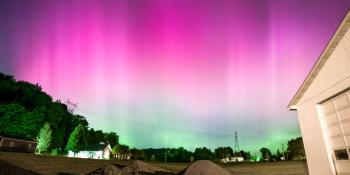Viendo archivo del viernes, 4 marzo 2011
Informe actividad solar
Any mentioned solar flare in this report has a scaling factor applied by the Space Weather Prediction Center (SWPC). Because of the SWPC scaling factor, solar flares are reported as 42% smaller than for the science quality data. The scaling factor has been removed from our archived solar flare data to reflect the true physical units.
Informe de actividad Solar-Geofísica 2011 Mar 04 2200 UTCPreparado por NOAA © SWPC y procesado por SpaceWeatherLive.com
Informe conjunto USAF/NOAA de actividad Solar y Geofísica
SDF Número 063 Publicado el 2200Z a las 04 Mar 2011IA. Análisis de regiones solares activas y de actividad desde 03-2100Z hasta 04-2100Z Solar activity was low. Several small C-class flares
were observed from Region 1164 (N23W14). This region was classified
as an Ekc type spot group with Beta-Gamma-Delta magnetic
characteristics. Region 1166 (N09E55) more than tripled in size
over the past 24 hours and the number of spots doubled. Region 1166
was classified as an Eac type spot group with Beta magnetic
characteristics. Region 1168 (N24W73) emerged on the disk as a
small bipolar group. Two East limb CMEs were observed in both SOHO
LASCO and STEREO imagery, although neither appeared to be
Earth-directed.
IB. Pronóstico de la actividad solar
Solar activity is expected to be low.
More C-class flares are expected from Regions 1164 and 1166, with a
chance for an M-class flare.
IIA. Resumen de la actividad geofísica 03-2100Z a 04-2100Z
The geomagnetic field was quiet to unsettled. A waning coronal hole
high speed stream remained geoeffective and solar wind speed at the
ACE spacecraft was approximately 500 km/s. The greater than 2 MeV
electron flux at geosynchronous orbit was at high levels throughout
the period.
IIB. Pronóstico de la actividad geofísica
The geomagnetic field is
expected to range from quiet to active levels with a slight chance
for minor storm periods at high latitudes for the next three days
(05-07 March). Model guidance suggests a possible arrival on day
two (06 March) of an Earth-directed CME observed early on 03 March.
This slow-moving CME is expected to bring a slight chance for major
storm conditions at high latitudes. Activity levels are anticipated
to decrease on day three (07 March).
III. Probabilidades del evento 05 Mar a 07 Mar
| Clase M | 35% | 35% | 35% |
| Clase X | 01% | 01% | 01% |
| Protón | 01% | 01% | 01% |
| PCAF | Green | ||
IV. Penticton 10.7cm flujo
Observado 04 Mar 127 Previsto 05 Mar-07 Mar 125/125/125 Media de 90 Días 04 Mar 089
V. Índices Geomagnéticos A
Observado Afr/Ap 03 Mar 011/012 Estimado Afr/Ap 04 Mar 010/012 Previsto Afr/Ap 05 Mar-07 Mar 010/012-008/010-005/010
VI. Probabilidades de Actividad Geomagnética 05 Mar a 07 Mar
| A. Latitudes Medias | |||
|---|---|---|---|
| Activo | 20% | 25% | 05% |
| Tormenta Menor | 05% | 10% | 01% |
| Tormenta Mayor-Severa | 01% | 05% | 01% |
| B. Latitudes Altas | |||
|---|---|---|---|
| Activo | 25% | 30% | 25% |
| Tormenta Menor | 10% | 15% | 10% |
| Tormenta Mayor-Severa | 05% | 10% | 05% |
All times in UTC
< < Ir a la visión general diaria
Últimas noticias
Últimos mensajes del foro
AR3685 46Anomaly.. 18May 2024 Geomagnetic Storms from AR 13664 (2) 322Growth of Cycle 25 437Incoming Active Regions 367
Más temasApoye a SpaceWeatherLive.com!
Mucha gente viene a SpaceWeatherLive para seguir la actividad del Sol o previsión de aurora, pero con esta cantidad de tráfico se incrementan los costos del servidor. ¡Considere hacer una donación si disfruta de SpaceWeatherLive para que podamos mantener el sitio web en línea!

Hechos clima espacial
| Último evento clase X | 2024/05/15 | X2.9 |
| Último evento clase M | 2024/05/17 | M7.1 |
| Últimas tormentas geomagnéticas | 2024/05/17 | Kp6 (G2) |
| Días sin manchas | |
|---|---|
| Último día sin manchas | 2022/06/08 |
| Promedio de manchas solares mensuales | |
|---|---|
| abril 2024 | 136.5 +31.6 |
| mayo 2024 | 157.2 +20.7 |
| Last 30 days | 174.3 +64.2 |


